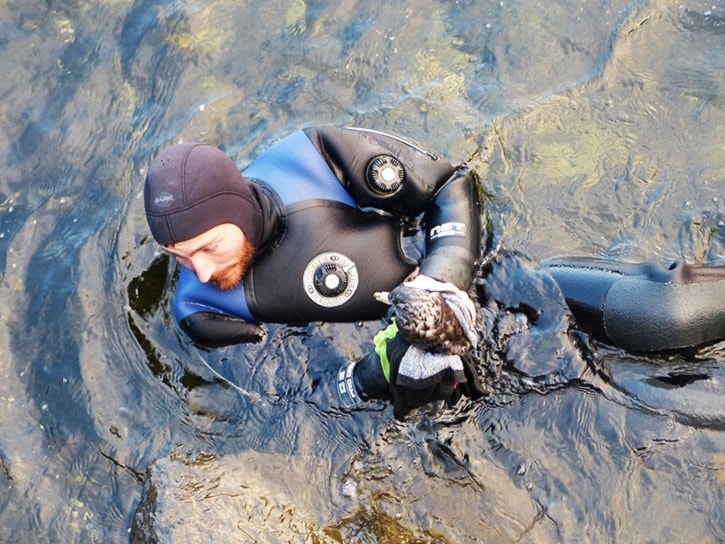Ucluelet local Andrew McCurdy dove into the ocean and swam roughly 200 metres to rescue a drowning seabird.
McCurdy is a marine biologist with the Ucluelet Aquarium and saw the bird acting strangely from the aquarium’s ocean-facing windows during a Nov. 17 storm.
He told the Westerly he initially thought the bird might be bathing but he quickly realized it was in trouble.
“He tried to take off a few times but just couldn’t quite raise his wings and I could tell they were totally saturated with water,” he said. “It was clear that he was trying to take off but couldn't.”
McCurdy had never seen a fulmar before and didn’t recognize the animal.
“The first thing I did was try to figure out what kind of bird it was just to see if what it was doing was normal because, of course, I don't want to try to rescue a bird that’s totally fine; that’s just going to freak them out,” he said.
He identified the bird as a fulmar and called the North Island Wildlife Recovery Association in Errington for more information.
His call was answered by the association’s wildlife manager Julie Mackey who told him fulmars can over-exhaust themselves and drown.
“After I learned that, I thought I better jump in and pull him out,” McCurdy said. “I popped on my dry-suit, swam out there and got him.”
Mackey told the Westerly the sanctuary receives a lot of wildlife related calls but few like McCurdy’s.
“I’ve learned in my years doing this that you get some very interesting phone calls,” she said. “Most people don’t go to that extent to help wildlife so it’s awesome when we hear of people like this.”
She added McCurdy likely saved the fulmar’s life.
“If they’re struggling in the water, they can struggle to the point of exhaustion and they can die from that so it was awesome that he was able to get that guy out,” she said.
McCurdy said he swam about 100 metres to the bird and brought it back to the aquarium, where it was toweled off and placed in a ventilated box to rest.
“It was actually pretty simple,” he said. “He was definitely very tired when I got up to him. He, kind of, eyed me up and I eyed him up before I grabbed him but he didn’t really struggle too much.”
The fulmar spent the night with aquarium curator Laura Griffith-Cochrane and was released the following morning.
“He was looking pretty good in the morning when we let him go,” McCurdy said.
He downplayed his heroics.
“I wanted to help him out. It looked like he was having trouble and I figured I could help so why not? It wasn’t a big deal for me to get out there and get him,” he said.
“I’m glad I could help him out but it was a simple thing for me to do to get him out of there and give him another chance.”
He encourages anyone who sees an animal in trouble to contact the aquarium at 250-726-2782 or info@uclueletaquarium.org.
“They’re welcome to call us up to ask questions about it and we can either help out with what’s going on or at least direct them to the proper organizations,” he said.
Mackey said she usually encourages people to bring animals into the bird rehab centre in Errington but acknowledged that while it is the closest centre to the West Coast, the commute is tough for West Coasters to make.
“We don't have staff or volunteers in that area so we really have to rely on people to call us,” she said. “People can call with questions or problems and we’ll try and help them out.”
The centre can be reached at 250-248-1274.
Fulmars are small birds measuring roughly 50-centimetres-long and Mackay said, like most seabirds, they are rarely seen from the shore.
“We don’t see a lot of them but generally we do get calls about that type of bird after windstorms when they’ve been blown off course,” she said.
“We’ll get calls from the Tofino area from people who have found seabirds on shore after a storm. Usually they’re not injured, they’ve just been blown onto shore and a lot of those birds can’t physically take off from land.”
andrew.bailey@westerlynews.ca
